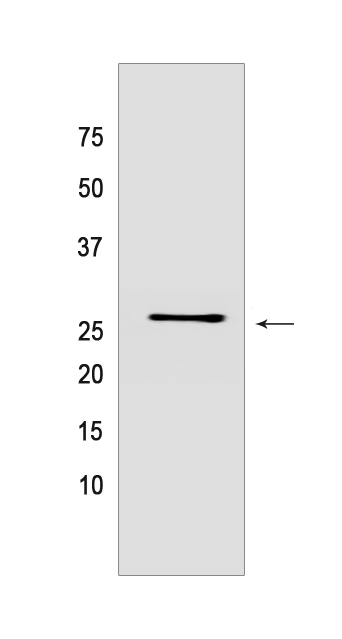HSD17B8 Rabbit mAb [UK7M]Cat NO.: A99447
Western blot analysis of extracts from Human fetal liver tissue lyaste.using HSD17B8 Rabbit mAb [UK7M] at dilution of 1:1000 incubated at 4℃ over night
Product information
Protein names :HSD17B8,FABGL,HKE6,RING2,SDR30C1,DHB8_HUMAN,-3-hydroxyacyl-CoA dehydrogenase
UniProtID :Q92506
MASS(da) :26,974
MW(kDa) :26 kDa
Form :Liquid
Purification :Protein A purification
Host :Rabbit
Isotype :IgG
sensitivity :Endogenous
Reactivity :Human
- ApplicationDilution
- 免疫印迹(WB)1:1000-2000
- 免疫荧光(ICC/IF)1:100,
- The optimal dilutions should be determined by the end user
Specificity :Antibody is produced by immunizing animals with a synthetic peptide of Human HSD17B8.
Storage :Antibody store in 10 mM PBS, 0.5mg/ml BSA, 50% glycerol. Shipped at 4°C. Store at-20°C or -80°C. Products are valid for one natural year of receipt.Avoid repeated freeze / thaw cycles.
WB Positive detected :Human fetal liver tissue lyaste
Function : Required for the solubility and assembly of the heterotetramer 3-ketoacyl-[acyl carrier protein] (ACP) reductase functional complex (KAR or KAR1) that forms part of the mitochondrial fatty acid synthase (mtFAS). Alpha-subunit of the KAR complex that acts as a scaffold protein required for the stability of carbonyl reductase type-4 (CBR4, beta-subunit of the KAR complex) and for its 3-ketoacyl-ACP reductase activity, thereby participating in mitochondrial fatty acid biosynthesis. Catalyzes the NAD-dependent conversion of (3R)-3-hydroxyacyl-CoA into 3-ketoacyl-CoA (3-oxoacyl-CoA) with no chain length preference,this enzymatic activity is not needed for the KAR function (PubMed:19571038, PubMed:25203508, PubMed:30508570). Prefers (3R)-3-hydroxyacyl-CoA over (3S)-3-hydroxyacyl-CoA and displays enzymatic activity only in the presence of NAD(+) (PubMed:19571038). Cooperates with enoyl-CoA hydratase 1 in mitochondria, together they constitute an alternative route to the auxiliary enzyme pathways for the breakdown of Z-PUFA (cis polyunsaturated fatty acid) enoyl-esters (Probable) (PubMed:30508570). NAD-dependent 17-beta-hydroxysteroid dehydrogenase with highest activity towards estradiol (17beta-estradiol or E2). Has very low activity towards testosterone and dihydrotestosterone (17beta-hydroxy-5alpha-androstan-3-one). Primarily an oxidative enzyme, it can switch to a reductive mode determined in the appropriate physiologic milieu and catalyze the reduction of estrone (E1) to form biologically active 17beta-estradiol (PubMed:17978863)..
Tissue specificity :Widely expressed, particularly abundant in prostate, placenta and kidney (PubMed:17978863). Expressed at protein level in various tissues like brain, cerebellum, heart, lung, kidney, ovary, testis, adrenals and prostate (PubMed:30508570)..
Subcellular locationi :Mitochondrion matrix.
IMPORTANT: For western blots, incubate membrane with diluted primary antibody in 1% w/v BSA, 1X TBST at 4°C overnight.


